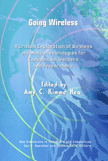Part II: Examining Teacher and Student Subjectivities in the Age of Wireless and Mobile Technologies
Karla Saari Kitalong starts out part II with "'A Whole New Breed of Student out There': Wireless Technology Ads and Teacher Identity," an analysis of how teacher subjectivities are created by wireless technology advertisements that espouse the technology's importance to education. Interestingly, Kitalong finds a surprising lack of teacher representation in these ads, despite the fact that many of them appear in publications written for teachers. This results, she argues, in constraining teachers' "identity potential." Kitalong defines identity potential as
the repertoire of available beliefs and behaviors from which an individual can draw, based on factors such as race, gender, ethnicity, subcultural affiliation, educational and professional attainments. (p. 54)
While I do wish that Kitalong would have explored in more detail how these ads alone are so powerful in limiting one's identity potential given all of these factors, her conclusions are nonetheless fascinating, theoretically rich, and useful when we consider how teachers construct themselves within the information environments our students inhabit.
As a solution, Kitalong provides Stuart Selber's computer literacy taxonomy which serves as "a toolkit teachers can employ to help broaden their own identity potential within the conceptual landscape of technological literacy," especially in the face of technology implementation strategies which seek to render teachers as invisible within new technological landscapes (p. 55).
Ryan M Moeller's contribution to this section of the book, entitled "Rewriting Wi-fi: The Surveillance of Mobility and Student Agency" makes an interesting case for wireless technologies that allow surveillance to be prevalent yet invisible. Moeller identifies four separate rhetorical appeals made in favor of wireless technology that bring, along with the benefits they espouse, drawbacks and ultimately, increased surveillance. These appeals are, in turn, refiguring work, making entertainment productive, selling security, and promoting deregulation.
While these appeals refigure work and make entertainment productive, they also make the case for networks to be more ubiquitous, selling security and deregulation along the way in order to build a case for the desirability and ease of increased surveillance. Moeller asks us to confront these appeals in our writing classes by deploying Berlin's social-epistemic rhetoric in order to interrogate the invisibility of the wireless networks in which we work and play, the ways that this world is designed to collapse work and play into a single context, and the ways they are meant to make us more surveillable.
Part two concludes with Melinda Turnley's "Reterritorialized Flows: Critically Considering Student Agency in Wireless Pedagogies," in which she raises the point that "As we consider the potentials of wireless pedagogies [...], we should examine educational practices not only within classrooms but also those outside traditional academic spaces" (p. 87). It is in this chapter that the recurring theme for the book emerges about the importance of space-based metaphors in interrogating what mobile technologies mean for writing.
Turnley takes on the utopian determinist stance that networks are
neutral spaces that automatically equalize all environments and student positions [which] present learning as individualized, decontextualized process and serve to reinscribe social hierarchies surrounding issues of access and academic success. (p. 89)
As a counterpoint to this utopian stance, Turnley proposes using Deleuze and Guattari's theories of deterritorialization and reterritorialization in which motion and connection are more important than staking out static ideological positions. The ideas of motion and connection are particularly apt when we consider the implications of the growing trend toward online and hybrid writing classrooms in our networked universities, and our students' relationships to the technology and the assumption that all college students come to the university classroom with certain levels of comfort and experience in technologically-driven writing environments.
